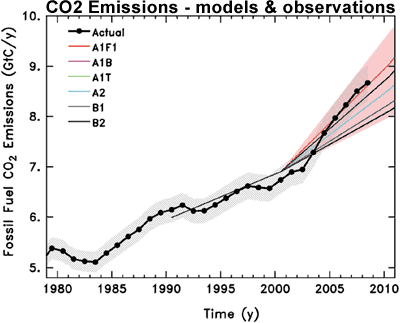
Figure 1: Observed global CO2 emissions from fossil fuel burning and cement production compared with IPCC emissions scenarios. The coloured area covers all scenarios used to project climate change by the IPCC.
Global warming is happening before our very eyes. All over the world, from the Arctic to Antarctica, scientists are observing the impacts of climate change. In the three years since the IPCC Fourth Assessment Report (AR4) was drafted, hundreds of peer reviewed papers studying climate change have been published. A summary of the latest research has been compiled in The Copenhagen Diagnosis, released by the University of NSW and authored by 26 climate scientists. It's a resource heavy report, referencing hundreds of papers. Here are some of the highlights:
At a time when we need to be lowering our carbon footprint, global CO2 emissions have been sharply rising. In fact, the acceleration in fossil fuel CO2 emissions is tracking the worst case scenarios used by the IPCC AR4. Consequently, atmospheric CO2 is increasing ten times faster than any rate detected in ice core data over the last 22,000 years.

Figure 1: Observed global CO2 emissions from fossil fuel burning and cement production compared with IPCC emissions scenarios. The coloured area covers all scenarios used to project climate change by the IPCC.
Over the past 25 years, global temperature has warmed at a rate of ~0.2°C per decade. Superimposed over this long term trend is short term variability. Most of these short-term variations are due to internal oscillations like El Niño Southern Oscillation, the 11-year solar cycle and volcanic eruptions. Over periods less than a decade, such short-term variations can outweigh the anthropogenic global warming trend. For example, El Niño events can change global temperature by up to 0.2°C over a few years. The solar cycle imposes warming or cooling of 0.1°C over five years. However, neither El Niño, solar activity or volcanic eruptions make a significant contribution to long-term climate trends. Consequently, over the past decade (1999-2008), the warming trend is 0.19°C per decade. consistent with the long term trend.

Figure 2: Global temperature according to NASA GISS data since 1980. The red line shows annual data, the red square shows the preliminary value for 2009, based on January-August. The green line shows the 25-year linear trend (0.19 °C per decade). The blue lines show the two most recent ten-year trends (0.18 °C per decade for 1998-2007, 0.19 per decade for 1999-2008).
Satellite and tide-gauge measurements show that sea level rise is accelerating faster than expected. The average rate of rise for 1993-2008 as measured from satellite is 3.4 millimeters per year while the IPCC Third Assessment Report (TAR) projected a best estimate of 1.9 millimeters per year for the same period. Actual sea level rise is 80% higher than the median projection. Sea level is likely to rise much more by 2100 than the often-cited range of 18-59 centimeters from the IPCC AR4.

Figure 3: Sea level change. Tide gauge data are indicated in red and satellite data in blue. The grey band shows the projections of the IPCC Third Assessment report.
Summer-time melting of Arctic sea-ice has accelerated far beyond the expectations of climate models. The area of sea-ice melt during 2007-2009 was about 40% greater than the average prediction from IPCC AR4 climate models. The thickness of Arctic sea ice has also been on a steady decline over the last several decades. September sea ice thickness has been decreasing at a rate of 57 centimeters per decade since 1987.

Figure 4: Observed (red line) and modeled September Arctic sea ice extent in millions of square kilometers. Solid black line gives the average of 13 IPCC AR4 models while dashed black lines represent their range. The 2009 minimum has recently been calculated at 5.10 million km2, the third lowest year on record and still well below the IPCC worst case scenario.
Some more observations from the latest research:
There is a common theme emerging from the most recent peer reviewed research. When uncertainties expressed in the IPCC AR4 report are subsequently resolved, they point to a more rapidly changing and more sensitive climate than previously believed. Skeptics tend to characterise the IPCC as imposing an alarmist bias in their conclusions. The latest empirical data indicates the opposite is the case.
Posted by John Cook on Thursday, 26 November, 2009
 |
The Skeptical Science website by Skeptical Science is licensed under a Creative Commons Attribution 3.0 Unported License. |